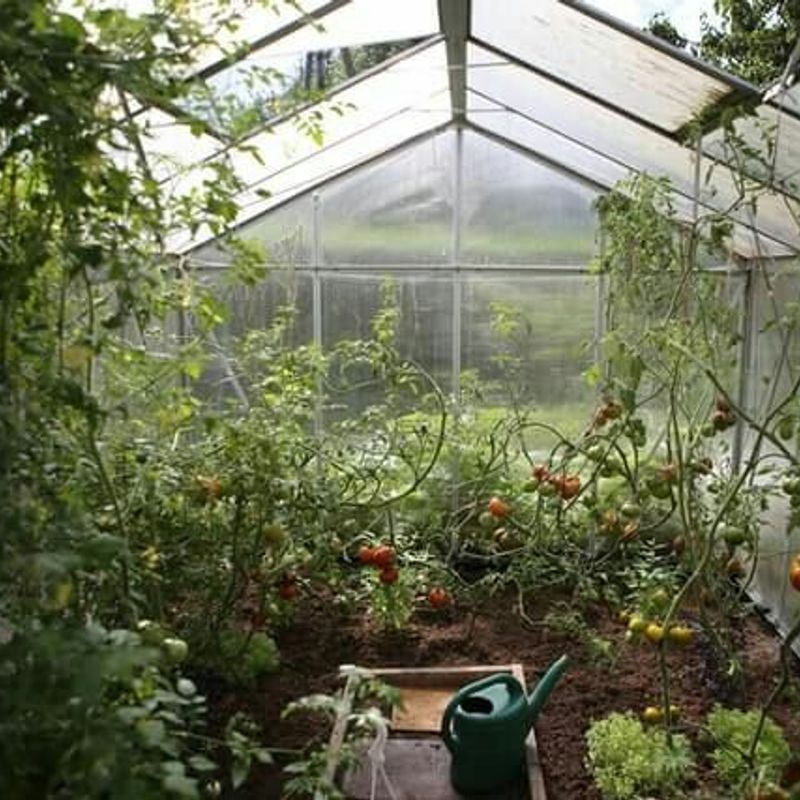Greenhouse Growing Guide

The Guide to Greenhouse Growing
Set up right in your backyard, greenhouses provide a stable, warm environment where plants can be grown throughout the year. They can also be used to get a head start on the growing season, by planting new seasons crops early. Or try “force growing” your spring bulbs in pots to bring inside the house when flower buds are showing. Greenhouses come in all different shapes, sizes and styles, so there’s something for everyone and every backyard.
Before you get started, you need to figure out how much growing space you need, both now and in the future – you don’t want to limit yourself in the years to come.
So where is the best place to put your greenhouse? If it’s closer to your house or garden, you’re much more likely to use it. This also makes it so much easier to get access to electricity and water – both of which will be very useful.
Ensure the area you choose has maximum exposure to the sun. Ideally the greenhouse will get at least 6 hours of direct sunlight each day.
Avoid placing your greenhouse near trees or other objects that will cast a shadow during winter months. Deciduous trees are the exception, however as they can provide much needed shade in summer, and lose their leaves in winter, allowing sunlight to get through.
Water – Water in the morning to avoid burning the plants leaves and water low down at the soil level rather than wetting the leaves to reduce risk of fungal or bacterial outbreak.
Ventilation – Your greenhouse really must have a roof vent to allow for air flow. Keep this vent and your door open during the day and close at night.
Pests & bugs – Control of whitefly can be achieved with non toxic whitefly traps that the bugs are attracted to. Hang these above your plants. Planting borage in your greenhouse will also deter whitefly and if things get carried away then use neem oil to manage an outbreak of bugs.
Too much summer sun – In the heat of the summer you can literally cook your plants. Glass is the best glazing material for greenhouses when it comes to letting sunlight and its warmth in, while keeping the elements out.
Too much wind– Your greenhouse needs to be in the sunniest, winter sun location for best growing results. This will give you the longer season time planting that is the benefit to growing indoors. Site your greenhouse where it is protected from wind and plant some great fast growing hedging like feijoa, griselinia littoralis or corokia to slow down the wind intensity. While your hedging plants are young then a simple trellis panel screen will act as some protection to your little shed.
GET ORGANIZED WITH OUR GREENHOUSE GROWING CALENDAR
Our simple planner explains what to sow when, with plenty of top tips, too.
JANUARY
Get ready to sow hardy salads and oriental greens like mustard greens, pak choi and winter varieties of lettuce towards the end of the month. Pinch out and plant in larger pots early sowings of sweet peas and onions.
Top tip: Bring compost for sowing or potting into the greenhouse several days before you need to use it so it doesn't chill seeds or young plants.
FEBRUARY
Get ahead for spring by sowing early carrots, salad leaves and spinach, which can be picked early in the season. Encourage potatoes to sprout before planting (the process known as chitting).
MARCH
Plant large-seeded, large-leaved veggies such as cucumbers and courgettes in individual pots, then place them in a propagator. The pots can be moved into the main body of the greenhouse about a month after sowing for an early July harvest. Sow a tray thickly with peas for a quick crop of shoots. Make sure you keep it well watered and turn it daily.
Sow broad beans in cardboard tubes to make planting out easy. These should also be watered regularly and turned so they grow straight.
Top tip: Be aware that spring can bring wide temperature fluctuations that will affect your greenhouse. Aim to keep the air temperature between 45–64°F (7–18ºC) by heating the greenhouse at night and ventilating and damping down during sunny days.
You should keep the door and vents open more frequently as March progresses, to keep humidity levels down and prevent disease.
APRIL
Veggies like carrots and peas can be sown outside in April, but you will still need to use your greenhouse for tender crops such as aubergines and courgettes.
MAY
Start off dwarf French beans in the greenhouse: they need warmth to germinate and can't survive frost. They can be transplanted into raised garden beds in four to six weeks. At this point in the greenhouse growing calendar, you can also sow sweetcorn. That way, you can enjoy buttery corn on the cob as part of summer feasts. Plan ahead for a harvest of kale throughout winter by starting the seeds off in the greenhouse this month.
JUNE
The mid-point of the greenhouse growing calendar calls for planting peas. Keep them in your greenhouse until they shoot to avoid them becoming a snack for mice. Plant them in newspaper pots or yoghurt containers to which you've added drainage holes.
JULY
Sow seeds of winter lettuces such as 'May King', 'Veneziana' and 'Winter Density' in the greenhouse in July. You can use an old ice cream tub to start them off, but separate them later in the month to allow them space to grow.
AUGUST
Swiss chard makes for a colorful autumn crop and the seeds should be sown in the greenhouse in August. Try 'Bright Lights', 'Magenta Sunset' and 'Rhubarb Chard'.
SEPTEMBER
Similar to cabbage but more delicately flavored and easier to grow, tatsoi can be sown this month. Doing so now when the shorter and cooler days begin reduces the risk of bolting, which makes the leaves bitter and unpalatable.
OCTOBER
Now is a good time to learn how to create a herb garden. Sow herbs such as basil, dill, chives and parsley for winter flavor for your recipes. You can also grow spring onions under a cloche ready to start harvesting in spring. For another spring crop, sow cauliflowers as well.
NOVEMBER
Plant and harvest microgreens in November. These are essentially small versions of the mature plant that are cut when they develop the first pair of leaves that looks like that of the adult plant. Try beetroot, broad beans, coriander, peas, radishes, rocket, spinach and swiss chard.
Top tip: Harvest microgreens with scissors – just as you would with cress – in as little as a week. You'll need to re-sow regularly to keep supplies going throughout winter.
DECEMBER
Heated greenhouse? Now's the time to sow tomatoes, peppers and chilies. No heating? Clean, tidy, and take the opportunity to get the greenhouse ready for growing veggies, salads and herbs next year, .perhaps by investing in some new greenhouse shelving ideas





